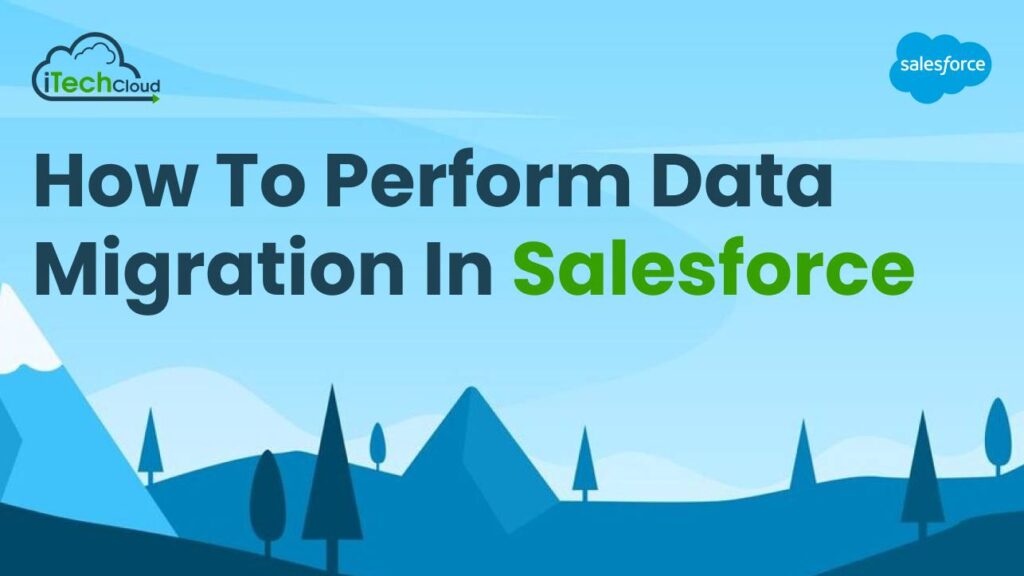How to Perform Data Migration in Salesforce

Introduction to Data Migration in Salesforce:
Data migration in Salesforce refers to the process of transferring data from one system to Salesforce, ensuring accuracy, integrity, and compatibility. It involves extracting data from various sources, mapping it to fit Salesforce’s structure, and loading it into the platform using tools like Data Loader or third-party solutions. Effective Data Migration in Salesforce is crucial for businesses transitioning to Salesforce, facilitating seamless operations, improved decision-making, and enhanced customer insights. Challenges such as data cleansing, deduplication, and maintaining data quality necessitate careful planning and execution to ensure a successful migration without disrupting business processes.
Table of Contents
Here’s a detailed guide on how to perform data migration in Salesforce:
1. Understand Data Requirements:
Before starting the migration process, it’s crucial to understand the data requirements. Analyze the data to be migrated, including its structure, volume, and dependencies. Identify the source system(s) from which data will be migrated and determine the target objects in Salesforce where the data will reside.
2. Data Mapping:
Create a data mapping document that maps the fields from the source system(s) to the corresponding fields in Salesforce objects. This mapping ensures that data is correctly transferred and aligned between systems. Include information about data transformations, if any, required during migration.
3. Data Cleansing and Transformation:
Cleanse the data in the source system(s) to ensure its quality before migration. This may involve deduplication, standardization, and validation of Data Migration in Salesforce. Perform any necessary data transformations to match the format and structure required by Salesforce.
4. Prepare Salesforce Environment:
Configure the Salesforce environment to accommodate the incoming data. Create or customize Salesforce objects, fields, and relationships as per the data mapping document. Ensure that all necessary permissions are set up to allow data import.
5. Choose Migration Tools:
Salesforce provides various tools for data migration, such as Data Loader, Data Import Wizard, and Salesforce APIs (e.g., SOAP, Bulk API). Choose the appropriate tool based on factors like data volume, complexity, and frequency of migration. For large-scale migrations, consider using Bulk API for faster Data Migration in Salesforce transfer.
6. Data Extraction:
Extract data from the source system(s) using the selected migration tool. Depending on the tool chosen, this may involve exporting data to CSV files, querying data via APIs, or using direct connectors to the source system.
7. Data Transformation and Loading:
Apply the data mapping and transformation rules to the extracted data before loading it into Salesforce. Use tools like Data Loader or Data Import Wizard to map fields, perform data transformations, and load data into Salesforce objects. Monitor the Data Migration in Salesforce loading process for any errors or inconsistencies.
8. Validate Data:
Once data is loaded into Salesforce, validate its accuracy and completeness. Run reports, perform data quality checks, and compare the migrated data with the source data to ensure consistency. Address any discrepancies or errors identified during validation.
9. Test Migration:
Conduct comprehensive testing of the migrated data to ensure that it meets the requirements and behaves as expected. Test various scenarios, including edge cases and data relationships, to validate the integrity of the migrated data.
10. Data Migration Cut-Over:
Plan the Data Migration in Salesforce cut-over carefully to minimize downtime and disruption to business operations. Coordinate with stakeholders to determine the appropriate timing for the cut-over and execute the migration plan accordingly. Ensure that all necessary preparations, including data backups and contingency plans, are in place before the cut-over.
11. Post-Migration Activities:
After completing the Data Migration in Salesforce, perform post-migration activities such as user training, data reconciliation, and performance tuning. Educate users on any changes to the data structure or processes resulting from the migration. Monitor system performance and address any issues or optimizations required.
12. Data Archiving and Retention:
Implement data archiving and retention policies to manage data storage and compliance requirements. Archive historical data that is no longer actively used but may be required for reporting or compliance purposes. Define retention periods for different types of data and ensure compliance with regulatory requirements.
13. Continuous Monitoring and Maintenance:
Continuously monitor the migrated data and Salesforce environment for any issues or anomalies. Implement regular data maintenance activities such as data deduplication, cleanup, and optimization to ensure data quality and system performance.
14. Documentation and Knowledge Sharing:
Document the entire data migration process, including the data mapping, transformation rules, migration plan, and post-migration activities. Share this documentation with relevant stakeholders to facilitate knowledge transfer and future reference.
15. Iterative Improvement:
Learn from the data migration experience and incorporate feedback to improve future migration processes. Identify areas for optimization, automation, or refinement and update the migration strategy accordingly for future migrations.
Conclusion:
Data migration in Salesforce involves transferring data from source systems to Salesforce while ensuring integrity and accuracy. To perform this task effectively, thorough understanding of data requirements, mapping, and cleansing is crucial. Salesforce offers various migration tools like Data Loader and APIs, chosen based on data volume and complexity. The process includes data extraction, transformation, loading, and validation.
Testing and careful planning of the migration cut-over are essential to minimize disruptions. Post-migration activities include user training, maintenance, and documentation. Continuous monitoring and iterative improvements ensure data quality and system performance. In conclusion, successful data migration in Salesforce demands meticulous planning, execution, and ongoing management to ensure a smooth transition and optimal utilization of Salesforce’s capabilities.

